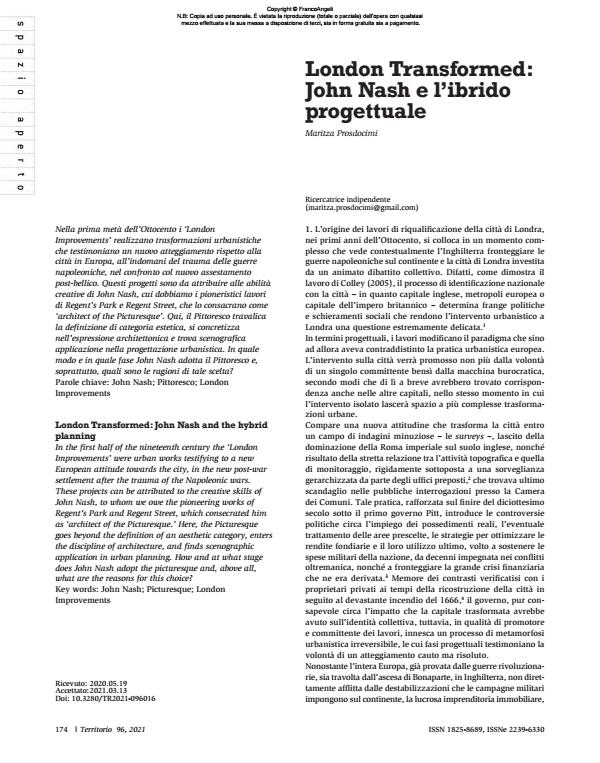London Transformed: John Nash and the hybrid planning
Journal title TERRITORIO
Author/s Maritza Prosdocimi
Publishing Year 2021 Issue 2021/96 Language Italian
Pages 16 P. 174-189 File size 1493 KB
DOI 10.3280/TR2021-096016
DOI is like a bar code for intellectual property: to have more infomation
click here
Below, you can see the article first page
If you want to buy this article in PDF format, you can do it, following the instructions to buy download credits

FrancoAngeli is member of Publishers International Linking Association, Inc (PILA), a not-for-profit association which run the CrossRef service enabling links to and from online scholarly content.
In the first half of the nineteenth century the ‘London Improvements’ were urban works testifying to a new European attitude towards the city, in the new post-war settlement after the trauma of the Napoleonic wars. These projects can be attributed to the creative skills of John Nash, to whom we owe the pioneering works of Regent’s Park and Regent Street, which consecrated him as ‘architect of the Picturesque.’ Here, the Picturesque goes beyond the definition of an aesthetic category, enters the discipline of architecture, and finds scenographic application in urban planning. How and at what stage does John Nash adopt the picturesque and, above all, what are the reasons for this choice?
Keywords: John Nash; Picturesque; London Improvements
- Archer J., 2000, Social unrest and popular protest in England. London: New studies in Economic and Social history, Cambridge University Press. DOI: 10.1017/CBO9780511612299
- Arnold D., 2005, Rural urbanism, London landscapes in the early nineteenth century. Manchester: Manchester University Press.
- Bonfantini B., 1994, «John Nash: dal pittoresco alla progettazione urbana». Spazio e Società, 66: 88-101.
- Bonfantini B., 2017, Dentro l’urbanistica. Ricerca e progetto, tecniche e storia. Milano: FrancoAngeli.
- Anderson J., 2009, «The operation of the Early Nineteenth-century Property Market». Construction History, 24: 63-81.
- Britton J., 1827, The original picture of London, enlarged and improved: being a correct guide for the stranger as well as for the inhabitant, to the metropolis of the British Empire. Together with a description of the environs, 26th edition, London: Longman.
- Barbon N., 1689, An apology for the builder (2nd ed.), London, reproduction of the original in the Guildhall Library.
- Clarke M., Penny N., 1982, The arrogant connoisseur: Richard Payne Knight 1751-1824, Manchester: Manchester University Print
- Clayton T., O’Connell S., 2015, Bonaparte and the British. London: The trustees of the British Museum.
- Colley L., 2005, Britons: Forging the Nation 1707-1830. New Heaven: Yale University Press.
- Colvin H., 1963a, A biographical dictionary of British architects, 1600-1840 (4th ed.). New Heaven: Yale University Press.
- Colvin H., 1963b, The history of King’s Works, London: H.M. Stationery Office.
- Cullen G. 1961, The concise Townscape, London: Routledge.
- Davis T., 1966, John Nash: the prince Regent’s architect. London: Newton Abbot.
- Fox C., 1992, Metropole London, Macht und Glanz einer Weltstadt, 1800-1840, Recklinghausen: Bongers.
- Glenbervie S., 1910, The Glenbervie journals. London: printed by W. Sichel.
- Gwynn J., 1766, London Transformed. London: printed for the Author.
- Haywood I., Seed J., 2012, The Gordon Riots. Cambridge: Cambridge University Press.
- Hoock H., 2010, Empires of the imagination: Politics, war and the arts in the British world 1750-1850. London: Profile Books.
- Hussey C., 1927, The picturesque: studies in a point of view. London: Frank Cass & Co.
- Kostof S., 1991, The City Shaped: Urban Patterns and Meanings Through History. London: Thames and Hudson.
- Kostof S., 1992, The City Assembled: Elements of Urban Form through History. London: Thames and Hudson.
- Kruft H.-W., 1994, A history of the architectural theory, New York: Princeton Architectural Press.
- Longstaffe-Gowan T., 2012, The London Square. Gardens in the Midst of Town. New Haven: Yale University Press.
- Navickas K. (2016) Protest and the Politics of space and place, 1789-1848. Manchester: University Press.
- Patetta L., 1975, L’architettura dell’eclettismo. Ed. 2008, Santarcangelo di Romagna (rn): Maggioli.
- Pevsner N., 2010, Visual planning and the picturesque. Los Angeles: Getty Research Institute.
- Porter R., 2000, London a social history. London: Penguin Books.
- Pugin A.C., Rowlandson T., 1947, The Microcosm of London. London: King Penguin.
- Romilly S., 1813, Memoirs of the life of Sir Samuel Romilly. London.
- Russel G., 1995, The Theatres of War, performance, politics and society, 1793-1815. Oxford: Clarendon Press.
- Saunders A., 1969, Regent’s Park, a study of the development of the park from 1086 to the present day. Davon: Newton Abbot.
- Shepherd T.H., Elmes J., 1826, Metropolitan Improvements. London: Jones & Co.
- Stevenson J., 1979, Popular disturbances in England, 1700-1832. New York: Longman Publishing.
- Stroud, 1962, Humphry Repton, London: Country Life.
- Suggett R., 1995, John Nash, architect in Wales. Aberystwyth: Immel Publishing.
- Summerson J., 1935, John Nash architect to George IV. London: George Allen & Unwin.
- Summerson J., 1945, Georgian London, (ed.1962) London: Pelican Books Summerson J., 1980, The life and work of John Nash. London: Allen & Unwin.
- Teyssot G., 1974, Città e utopia nell’illuminismo inglese: George Dance il giovane. Roma: Officina.
- Trevelyan G.M., 1964, English social History. London: Pelican Book. Tyack G., 2013, John Nash architect of the picturesque. London: English Heritage.
- Unwin R., 1909, Town planning in practice, (ed.1994) New York: Princeton Architectural Press.
- Watkins C., Cowell B., 2012, Uvedale Price, decoding picturesque, Woodbridge: Boydell and Brewer.
- White J., 1814, Some account of the proposed improvements of the western part of London by the formation of the Regent’s Park, the New Street, the new sewer. London: Reynolds.
- Youings J, 1971, The Dissolution of the Monasteries, New York: Barnes and Nobles.
Maritza Prosdocimi, London Transformed: John Nash e l’ibrido progettuale in "TERRITORIO" 96/2021, pp 174-189, DOI: 10.3280/TR2021-096016